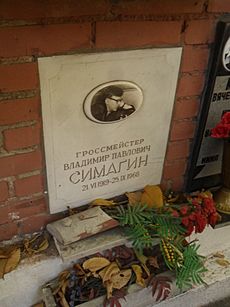Vladimir Simagin facts for kids
Vladimir Simagin (born June 21, 1919, in Moscow; died September 25, 1968, in Kislovodsk) was a talented Russian Grandmaster of chess. He won the Moscow City Chess Championship three times (in 1947, 1956, and 1959). Simagin also helped train Vasily Smyslov, who later became a World Champion. He made many important contributions to the way chess games begin, known as chess openings. He passed away while playing in a tournament.
Contents
A Chess Journey
Vladimir Pavlovich Simagin was a respected Soviet chess player and teacher. He became famous in chess a bit later in life, partly because World War II stopped many chess competitions for several years. He earned the International Master title in 1950. This was the same year that FIDE, the world chess organization, first introduced this title. Later, in 1962, he achieved the highest title in chess: Grandmaster.
Simagin was also very good at Correspondence chess, where players send their moves to each other over time. He became an International Master in correspondence chess in 1965 and was the Soviet correspondence champion in 1964.
Early Successes
One of Simagin's first big achievements was coming in second place at the 1946 Moscow Championship. He scored 11 out of 15 points, just behind the winner, David Bronstein. In 1947, he tied for first place in the Moscow Championship with Bronstein and Georgy Rivinsky. Simagin then won the playoff matches to become the champion. Also in 1947, he tied for first in the Spartak Club Championship and won that playoff too.
Training a Champion
Simagin, along with another chess master named Vladimir Makogonov, spent several years coaching Vasily Smyslov. Their training helped Smyslov become the World Chess Champion in 1957. This shows how skilled Simagin was not just as a player, but also as a mentor.
Simagin continued to play well in tournaments throughout his career. Some of his best results include tying for second place at a tournament in Sarajevo in 1963 and tying for first place at a tournament in Sochi in 1967.
Simagin's Chess Style
Vladimir Simagin was known for his exciting and creative way of playing chess. He was excellent at tactics, which means he was great at finding clever moves that could surprise his opponents and win material or gain an advantage. His playing style has been compared to famous players like Richard Réti and Bent Larsen.
New Ideas in Openings
Simagin was very original when it came to chess openings. He came up with many new ideas and variations that are still studied today. Here are a few examples:
- The Accelerated Dragon variation in the Sicilian Defence.
- A specific variation in the Grünfeld Defence.
- The Simagin variation in the Nimzo-Indian Defence. This opening starts with moves like 1.d4 Nf6 2.c4 e6 3.Nc3 Bb4 4.e3 0-0 5.Nge2 d5 6.a3 Bd6.
- Simagin's Defence, which begins with 1.e4 d6 2.d4 c6 3.Nf3 Bg4.
- In the King's Indian Defence, there's a line called the Simagin Variation (1.d4 Nf6 2.c4 g6.3.g3 Bg7 4.Bg2 O-O 5.Nf3 d6 6.Nc3 Nc6 7.O-O Bg4). He also explored other moves like 7...Bf5 (known as the Lesser Simagin) and 7...Bd7 (the Least Simagin). These variations show his deep thinking about how games could start.
Respected by Peers
Other top chess players highly respected Simagin. David Bronstein wrote very positive things about him in his book The Sorcerer's Apprentice. Even Mikhail Botvinnik, a former World Champion, relied on Simagin's help. In 1966, Simagin, who was an editor for the Bulletin of the Central Chess Club, helped Botvinnik publish an important article.
The Russian chess writer Lev Khariton wrote a touching tribute to Simagin. Khariton met Simagin as a young player and trained with him. Khariton shared a quote from Simagin: "In chess, as in life, all the time you have to overcome obstacles." He explained that Simagin believed every move in chess creates a new challenge to overcome.
Khariton described Simagin as a "modest and humble" person who would always stand up for what was right. He felt sad that Simagin's name is almost forgotten today. However, Khariton believed that Simagin was a true "chess artist" whose games show the beauty of chess and whose name should be remembered forever in chess history.


